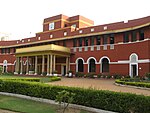Barakhamba Road metro station
2005 establishments in DelhiDelhi Metro stationsDelhi Metro stubsDelhi railway station stubsRailway stations in New Delhi district ... and 2 more
Railway stations opened in 2005Use Indian English from July 2015

The Barakhamba Road metro station is located on the Blue Line of the Delhi Metro. It was constructed by the Shapoorji Pallonji Group.It is located on Barakhamba Road near Modern School and the Statesman House, which houses many offices, banks, the Oxford bookstore and numerous other commercial institutions.
Excerpt from the Wikipedia article Barakhamba Road metro station (License: CC BY-SA 3.0, Authors, Images).Barakhamba Road metro station
Barakhamba Road, New Delhi Connaught Place
Geographical coordinates (GPS) Address Nearby Places Show on map
Geographical coordinates (GPS)
| Latitude | Longitude |
|---|---|
| N 28.62998 ° | E 77.224526111111 ° |
Address
Barakhamba Road
Barakhamba Road
110001 New Delhi, Connaught Place
Delhi, India
Open on Google Maps






